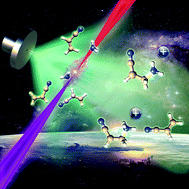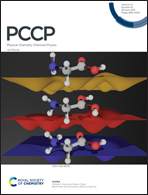Spectroscopic evidence of the C–N covalent bond formed between two interstellar molecules (ISM): acrylonitrile and ammonia†
Abstract
Acrylonitrile (AN) and ammonia (NH3) are two important nitrogen-containing interstellar molecules in outer space, especially on Titan. Herein, we measured infrared (IR) spectra of neutral and cationic AN–NH3 complexes by VUV single-photon ionization combined with time-of-flight mass spectrometry. On combining IR spectra with the theoretical calculations, we found that the molecules prefer to form a single-ring cyclic H-bonded structure in the neutral AN–NH3 and (AN)2–NH3 clusters. However, after ionization of AN–NH3 and (AN)2–NH3 clusters, a new C–N-covalent bond is confirmed to form directly between AN and NH3, without any energy barrier in the cationic complexes. Moreover, in the ionized (AN)2–NH3 cluster, the covalent C–N bond prefers to form between AN and NH3 rather than the two AN groups. These results provide spectroscopic evidence of AN forming a new molecule with NH3, induced by VUV radiation. The formation of the new C–N bond broadens our knowledge on the evolution of the prebiotic nitrogen-containing molecules in space.



 Please wait while we load your content...
Please wait while we load your content...